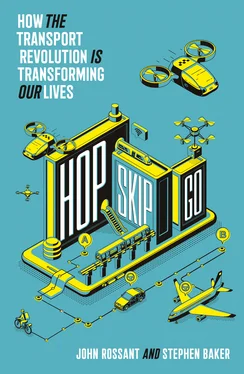This same logic extends to manufacturing. Car companies spend hundreds of billions of dollars to mass-produce legions of identical units. It’s a dumb, inflexible process. Lacking feedback loops to catch defects or to gauge popularity, an auto plant simply pumps out the units. If something’s wrong, the company issues hideously expensive recalls. And if certain aspects of the car or truck—the hood design, lumbar support, highway mileage—turn off buyers, there’s no easy fix. The structure is locked in. Failures cost hundreds of millions. It’s money down the drain.
In Czinger’s scheme, which he relates to biology, each car evolves. The 3-D printer process can spit out single specimens, which can be tested for speed, handling, comfort, fuel efficiency. This creates feedback loops. As test data comes in, the engineers can melt down the car and tweak the software design—the car’s DNA. They can spawn different species for varying markets—or ecosystems—perhaps one car for the long, flat boulevards of Torrance, another for the chaotic streets and alleys of Karachi.
The former noseguard gets most excited when talking about the most violent of feedback loops: crashes. Because most of a printed car can be melted down and recycled, it’s much cheaper to run them through crash tests. Each test will produce rich data on every material and design feature in the car. In Czinger’s vision, next-generation manufacturers around the world will crash their cars, scores of them, creating oceans of feedback data, which they’ll share with everyone else. “We’ll be swimming in crash data,” Czinger says. Once this data is fed into learning engines, they can analyze the performance of each component, gradually leading to the safest and most crashworthy designs. Such is the supple nature and competitive advantage of a manufacturing process that exists, in large part, as software.
DIVERGENT 3D REPRESENTS merely one stab at manufacturing the next generation of vehicles. Entrepreneurs around the world are busy devising new machines, and a good number of them are innovating with schemes simpler than Kevin Czinger’s robots and 3-D printers.
Many such start-ups are repurposing industrial machinery used to make stoves or bicycles. The result is an explosion of tinkering. VeloMetro, a Vancouver, British Columbia, start-up, created the Veemo, a three-wheeled electric-aided bicycle encased on three sides in an all-weather pod. Big companies are in on it, too. Renault’s Twizy, a featherweight electric automobile, looks like a go-cart. Its two doors rise up on its sides, like a bat’s wings. Over the coming decades, the streets and sidewalks of cities around the world will be crowded laboratories for a wild and diverse generation of mobility machines. They’ll look like something dreamed up for video games, or from a world inspired by Dr. Seuss.
In the college town of Eugene, Oregon, a former video-game designer named Mark Frohnmayer is putting together one such machine, an electric auto–motorcycle hybrid called Arcimoto. Imagine, for starts, turning a tricycle around, so that two wheels are in front, one behind. Then expand it to the size of a motorcycle, put in a couple of seats, one behind the other, and enclose it with an arc of plexiglass. These odd beasts are now rolling out of an Oregon manufacturing plant and selling for $11,000.
Frohnmayer, a UC Berkeley–educated computer scientist, succeeded early in his career as a video-game designer. One of his hits in the late 1990s, Starsiege: Tribes , was an early online multiplayer game set a couple thousand years into the future. Each player’s character was equipped with a gun, and he gathered with other tribes of humans for fights that jumped from one galaxy to the next. In 2001, Frohnmayer and his partners founded a software company called GarageGames. The idea was to develop easy-to-use tools for people to create their own video games. Six years later, Frohnmayer and his team sold the company to Barry Diller’s Internet conglomerate, IAC, for a reported $80 million.
This left him with a chunk of money and some free time. So he went shopping for a car. After a successful “exit,” as it’s called in the venture business, plenty of entrepreneurs might splurge on a Tesla S or a Porsche Panamera. But Frohnmayer is in Oregon, not the Valley. He’s the son of a university president, very idealistic, and, like many in the new mobility businesses, bright green and eager to save the world.
He was in the market for a socially responsible set of wheels, something to use when it was too wet to bike. He didn’t want to spend too much for it—maybe $10,000. He was disappointed. Even the cheapest cars seemed too big and cumbersome. He considered a motorcycle. It would be easy to park and fuel efficient. But motorcycling is miserable in the rain, which pretty much defines Eugene from October to June. Also, motorcycles are dangerous. People fly off them like missiles.
“What I saw,” Frohnmayer recalls, “is this enormous space between the motorcycle and the car.” Most trips around town, he said, involve one person, sometimes two, rarely more. So there had to be a market for people like him, who wanted a cheap and extremely fuel efficient electric vehicle for driving around town in bad weather, maybe just the mile or two to a train station or bus stop. The vehicle, he thought, should be as easy to park as a motorcycle, but as safe as a car, and with enough storage to bring home a few bags of groceries. He figured he could assemble a team to design this new species.
It turned out to be harder than software. “When you build a game in software,” he says, “you can copy it for no cost. You can fix a bug. Software is almost magical.” Manufacturing in the physical world, by contrast, proved to be “fantastically more complex.” Starting in 2008, his team in Eugene created one version after another of the two-seated roadster. This development went on for eight years—the entire Obama presidency. The Arcimoto team kept subbing in different materials and designs to reduce weight; they replaced handlebars with a steering wheel, then returned to handlebars again. They wedged stronger batteries into smaller nooks.
In all, they went through seven versions, and something was always … not quite right. But the eighth version sold them. It had a range of seventy-five miles. Though hardly a speed demon, the Arcimoto could still hold its own with cars, with a top speed of eighty miles per hour.
Finally, Frohnmayer had a green machine to strut before investors. In 2017, Arcimoto listed its stock on the Nasdaq Global Market and raised $19.5 million. That was enough to go into production. It launched sales early in 2019, but with a higher price than anticipated—some $19,900. Frohnmayer vowed to the press that with greater volume and expertise, they’d eventually get the price down to the $11,900 target. This is the tough learning curve start-ups face in manufacturing. The traditional players are wizards when it comes to mass production. No other industry has come close.
Arcimoto’s manufacturing is primitive, compared with Divergent 3D’s robotics and 3-D printing. In the Eugene factory, Arcimoto’s workers shear metal parts from sheets of steel, and then use a press to bend them to the right shapes—“Essentially sheet metal origami,” says Frohnmayer. The Arcimoto SRK, more motorcycle than car, is a far simpler vehicle than the cars Divergent 3D is designed to build. But Arcimoto also spent a lot less than the $50 million for a Divergent minifactory. The company has raised a mere $30 million in funding, and it already has its full manufacturing operation up and running. “And a lot of the money is still in the bank,” Frohnmayer says.
Читать дальше












